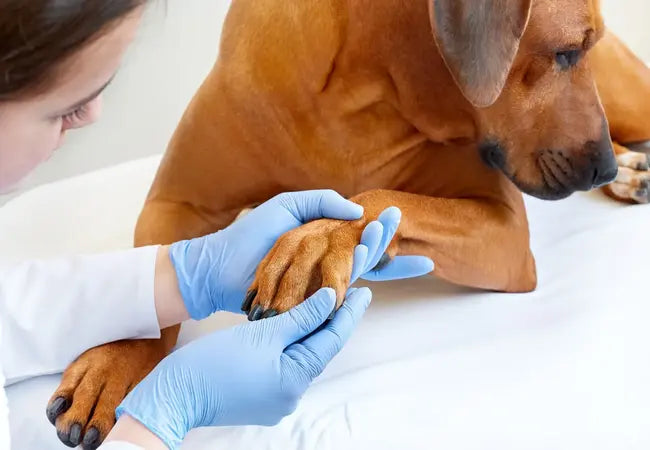Vet’s 2025 Guide to Canine Pododermatitis Healthy Paws Start Here 🩺🐾

In this article
Vet’s 2025 Guide to Canine Pododermatitis Healthy Paws Start Here 🩺🐾
By Dr. Duncan Houston BVSc
💡 Introduction
Pododermatitis refers to inflammation of a dog’s paws, encompassing the pads, interdigital skin, and nails. This can range from mild redness to severe ulceration, nodules, swelling, and even lameness.
1. What Causes Pododermatitis?
It’s seldom one single issue—most cases are multifactorial:
- Infections: bacterial (Staph), yeast (Malassezia), fungal, and parasites like Demodex or hookworms.
- Allergies: environmental (atopy), food, contact dermatitis from chemicals or carpet treatments.
- Immune‑mediated: e.g., pemphigus, lupus.
- Endocrine/metabolic: hypothyroidism, Cushing’s, zinc-responsive dermatosis, hepatocutaneous syndrome.
- Neoplasia: tumors like squamous cell carcinoma or melanoma.
- Trauma/irritants: burns, foreign bodies (foxtails), hard surfaces.
- Hyperkeratosis: excessive pad thickening, predisposing to cracking and microbial invasion.
2. Common Clinical Signs 🚨
- Red, swollen, itchy paws, often with hair loss and pigment changes.
- Pain evident by limping or reluctance to walk on hard ground.
- Ulcers, cysts, crusts, discharge—often secondary to licking.
- Lick granulomas from the compulsive licking of the feet.
3. Diagnostic Steps in 2025 🧪
3.1 Clinical Examination & History
- Take note of onset, duration, seasonality, paw exposure (chemicals, grass), and licking behavior.
- Check for concurrent skin or systemic issues to guide diagnostics.
3.2 Laboratory & Skin Testing
- Cytology: microscopic examination of swabs from infected pads for bacteria or yeast.
- Skin scraping: essential for mites like Demodex.
- Cultures: bacterial & fungal where indicated—especially chronic or unresponsive cases.
- Allergy trials: food elimination diets, intradermal allergy testing.
- Biopsy/X‑ray: for nodules, tumors, deep/invasive lesions.
- Bloodwork: CBC, thyroid, cortisol, zinc, liver enzymes to find systemic causes.
4. Treatment & Management ❤️
4.1 Treat Infections
- Antibiotics: Cephalexin, cefpodoxime, or injectable Convenia for bacterial pododermatitis.
- Antifungals: ketoconazole or fluconazole for yeast or fungal causes.
- Parasite therapy: topical/injectable for demodicosis; dewormers for hookworms.
4.2 Allergy & Immune Support
- Hypoallergenic diet with omega‑3 supplementation for food allergies.
- Atopic dermatitis: treat with antihistamines, corticosteroids, cyclosporine, or immunotherapy.
- Immune diseases: treat with glucocorticoids ± immunosuppressants like azathioprine.
4.3 Address Hormonal & Metabolic Causes
- Hypothyroidism/Cushing’s: hormone replacement or drug therapy.
- Zinc‑responsive dermatosis: supplement zinc + dietary support.
- Hepatocutaneous syndrome: complex nutritional therapy and supplementation.
4.4 Supportive & Home Care
- Foot soaks: Epsom salts or 1:10 vinegar to reduce moisture and infection.
- Protective booties: when walking on hot or rough surfaces—used intermittently.
- Topical hygiene: medicated wipes, mousses (e.g., Duoxo S3) to control local microbes.
- Prevent licking: Elizabethan collar or bitter sprays for lick granulomas.
- Pad care: trim hair, maintain pad flexibility, apply balms for hyperkeratosis.
5. Prognosis & Follow-Up
- Infection-based cases often cure in weeks; allergies and immune causes require lifelong management.
- Hormonal and metabolic conditions may need ongoing therapy, but good control significantly improves comfort.
- Biopsy-confirmed neoplasia prognosis varies—surgery, chemo, or radiation may help.
6. Prevention & Monitoring
- Regular paw checks and hygiene—especially after walks or in wet conditions.
- Environmental control: minimize allergens, clean floors, and avoid irritants.
- Healthy diet with essential fatty acids, balanced nutrition, and supplements with zinc if needed.
- Early vet visits at first lick, redness, or pain to prevent flare-ups.
7. Ask A Vet Support 🩺
- 24/7 triage for inflamed, painful paws.
- Cytology and scrape images shared for remote evaluation.
- Medication and soak reminders; track healing progress.
- Photo logs help monitor lesion changes and recurrence.
- Alerts for follow-up biopsies, blood testing, or referral.
🔍 Key Takeaways
- Pododermatitis is multifactorial—diagnosis relies on comprehensive testing.
- Effective treatment targets underlying causes (infection, allergy, immune, endocrine).
- Home care—soaks, protection, hygiene—supports clinic care.
- Many cases are curable; chronic ones manageable with regular monitoring.
- Ask A Vet bridges the gap between vet visits, offering real-time support.
🩺 Conclusion ❤️
Pododermatitis can cause intense discomfort—but with detailed diagnosis, tailored treatment, and effective home support, most dogs recover and thrive. In 2025, combining veterinary treatments with proactive tools like Ask A Vet ensures lasting paw health and happier steps. 🐾✨
Dr Duncan Houston BVSc – empowering pet owners with dermatology clarity and practical guidance.
Visit AskAVet.com and download the Ask A Vet app to track paw care, treatment schedules, and symptom changes—all from your phone. ❤️






